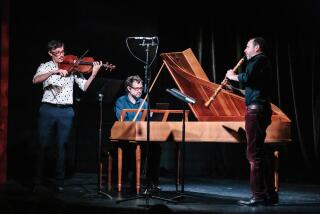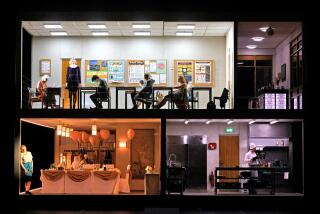Austria’s Hagen Quartet Paints With Strings’ Many Colors
- Share via
A thrilling return--it’s been quite a few years since its last visit here--marked the performance of the Hagen Quartet at the Irvine Barclay Theatre Tuesday night. Deeply accomplished, delightfully versatile and completely serious, the string quartet from Austria has myriad technical resources at its disposal and broad musical horizons.
Once again, its playing could not have been more emotionally resonant or probing.
The players are actually three Hagens and a Schmidt: The quartet is composed of violinists Lukas Hagen and Rainer Schmidt, violist Veronika Hagen and cellist Clemens Hagen (the three are siblings who formed the ensemble in 1982). On Tuesday, they played a program that looked forbidding on the page--with two taut, atonal Anton Webern works in the middle of the program--but produced both aural pleasures and spiritual lightness.
The centerpiece was the Schubert Quartet--No. 15, in G, D. 887--a memorable, breathtaking climax to the evening.
Its intense and sweeping opening movement seemed to be accomplished in a single exhalation, so tightly did its narrative proceed. The seraphic slow movement--dominated here by the singing tone and exigent leadership of cellist Clemens Hagen--offered Schubert-playing of the most deeply felt tension and release. The concluding movements followed that model, with no letup of concentration.
*
Throughout, and in the earlier part of the program, with the Ravel Quartet and two works of Webern--the Five Pieces of Opus 5 (1909) and the Six Bagatelles, Opus 9 (1913)--the players used a wide and richly detailed dynamic palette, huge contrasts and an aggressive delicacy, all toward expressive ends. The result was abundant and complex contrasts and details.
They use a world of technique to create and inform each composer’s discrete style.
Their Ravel was perfectly ethereal, its colors distinct from the intellectual distillation of the Webern--both proved energetic and authentic.
The results characterize a level of achievement toward which all other string quartets can aim.
More to Read
The biggest entertainment stories
Get our big stories about Hollywood, film, television, music, arts, culture and more right in your inbox as soon as they publish.
You may occasionally receive promotional content from the Los Angeles Times.










